The Allied Race to Victory: The Air, Land, and Sea Campaigns that Ended WWII
This exhibit from the Pritzker Military Museum & Library provided an overview of the battles and actions that led to the Allied victory in Europe and the Pacific.

The Allied Race to Victory
Learn more about the End of WWII exhibit "The Allied Race to Victory" at the Pritzker Military Museum & Library.

Pacific Area of Operations Map, 1944-1945
Overview map of the end of the war appears in the World War II exhibit The Allied Race to Victory at the Pritzker Military Museum & Library.

The Marianas Campaign
Overview of the Marianas Campaign during the end of WWII appears in the World War II exhibit The Allied Race to Victory at the Pritzker Military Museum & Library.

Map of the Mariana Islands
Map of the Mariana Islands and the Battle of the Philippine Sea, June 1944 - August 10, 1944.


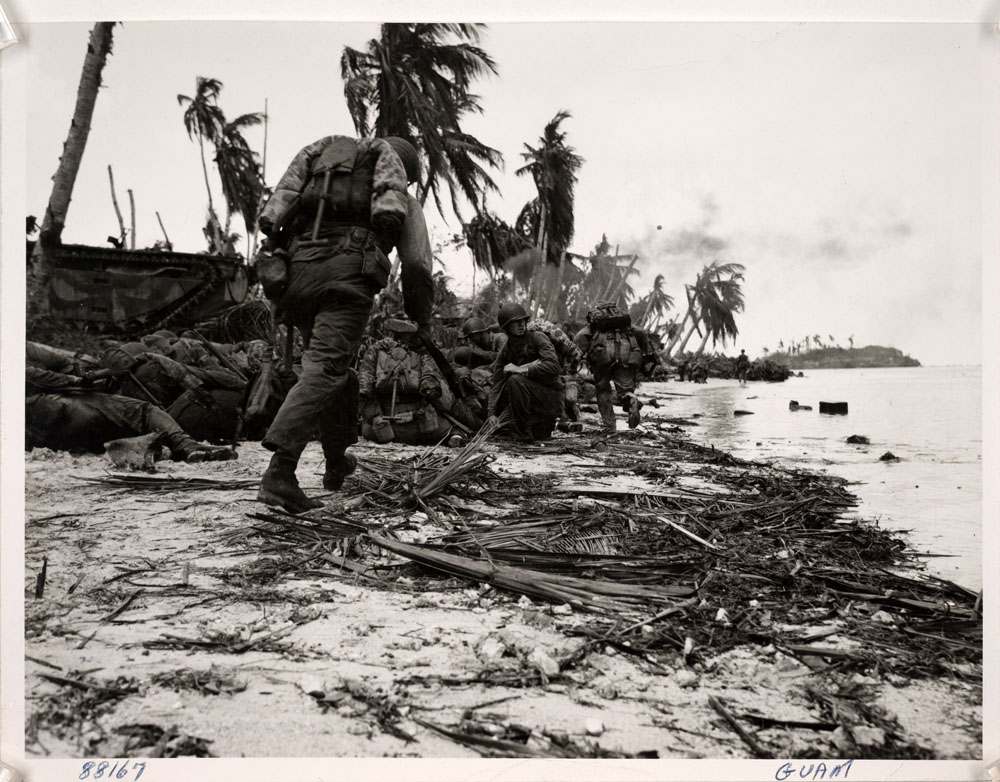

Pillbox Exterminators
Photo of Marines using flamethrowers on pillboxes and other defensive positions on Saipan.


Helldivers Advance on Japanese Fleet
Squadron of Grumman F6F Helldiver pilots setting out to intercept the Japanese attackers.
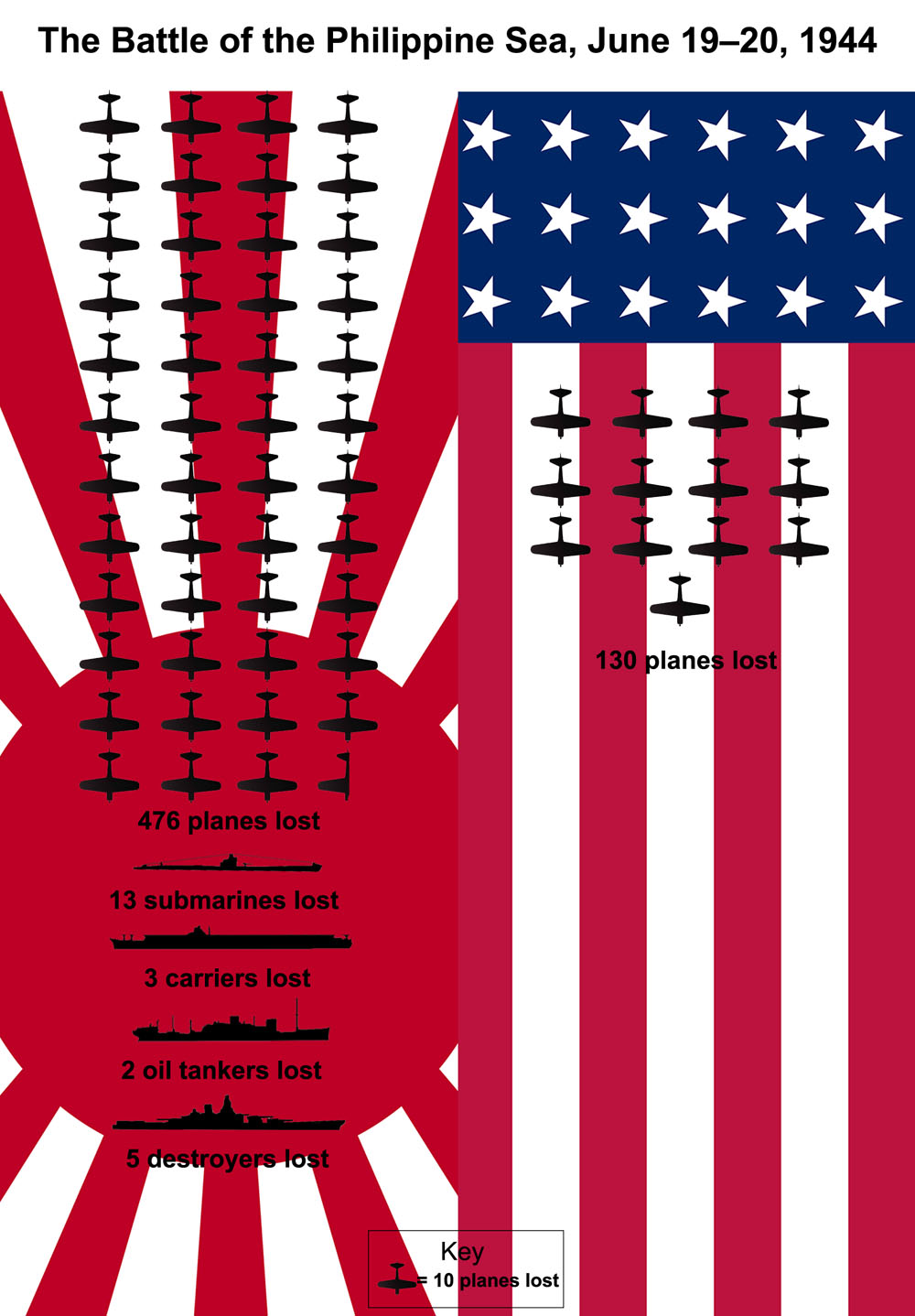

Japanese Ships Maneuver Under Fire
Japanese ships maneuvering under fire from U.S. Navy pilots during the Battle of the Philippine Sea.

Japanese Plane Shot Down as it Attempted to Attack USS Kitkun Bay
Japanese plane being shot down while attempting to attack USS Kitkun Bay during the Battle of the Philippine Sea.

USS Bunker Hill
USS Bunker Hill during the Battle of the Philippine Sea on June 19, 1944.



An Amphibious Tractor Burns as Marines Take Shelter After Landing on Peleliu
Marines taking shelter while an amphibious tractor burns in the distance on the island of Peleliu.

US Marines Rest Following the Capture of Peleliu
Marines resting following the capture of Peleliu.


Marine Indian Uses Walky-Talky
Marine Indian using a walky-talky during the Battle of Peleliu.
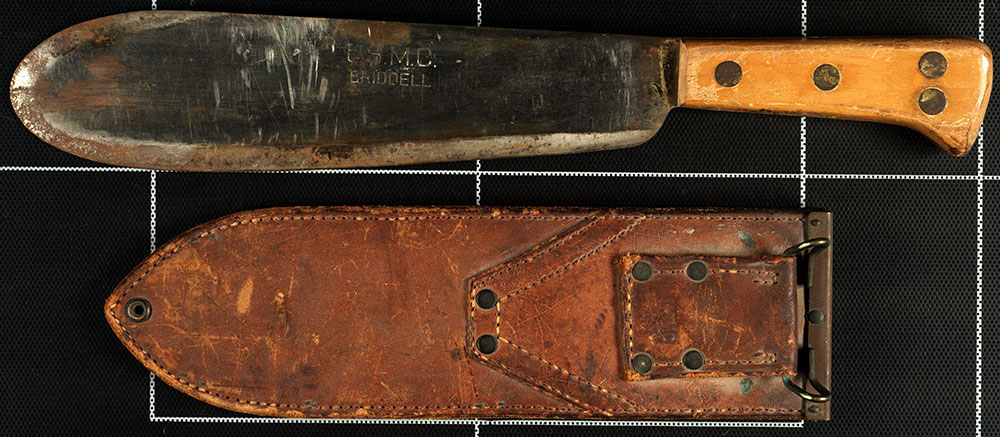

1st Marine Division Shoulder Sleeve Insignia
1st Marine Division Shoulder Sleeve Insignia.


Leyte
The invasion of Leyte by American forces to free the Philippines from the Japanese.

600 Ship Convoy Brings Yanks to Philippines
American landing crafts coming ashore to Leyte in the Philippines.

The 21st Infantry Regiment Prepares to Assault Leyte
The 21st Infantry Reigment preparing to assault the island of Letye.
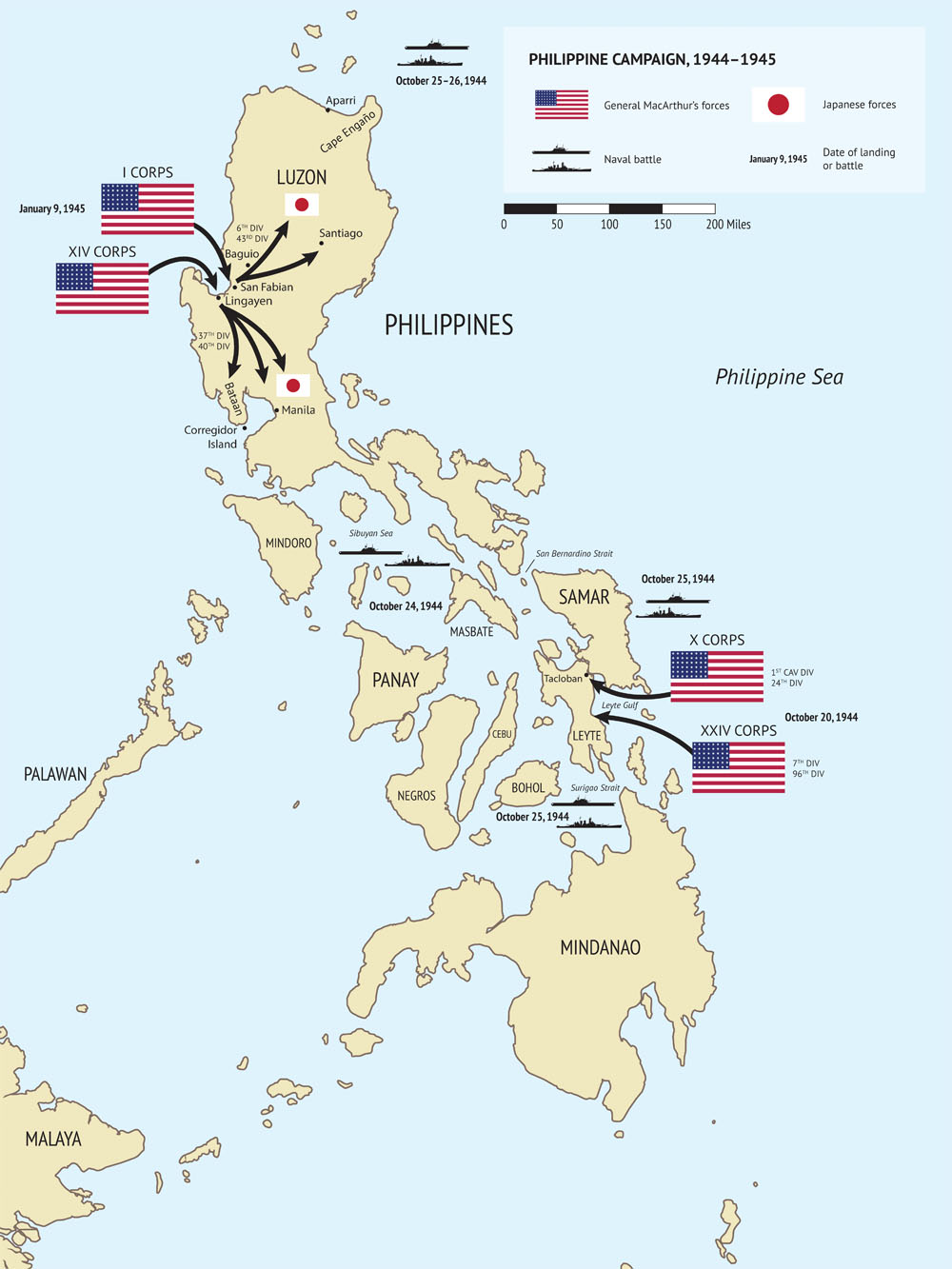

Leyte Island: First Wave Troops Land on Island
First wave of American troops on the island of Leyte.

12th Cavalry Moves Up from the Beach
The 12th Infantry Regiment moving up from the beaches of Leyte Island, meeting minimal hostility.

Iron Cavalry Drives Forward on Leyte
The Iron Cavalry driving forward on Leyte during the Philippine Campaign.

American Forces Fire Artillery at Japanese Defenses
American forces firing artillery at Japanese defenses during the Philippine Campaign.

General MacArthur in the Pacific
General McArthur in a line of jeeps with soldiers in the Pacific.

Battle of Leyte Gulf
Description of the Battle of Leyte Gulf where the Imperial Japanese Navy used bait to lure the U.S. 3rd fleet away from Leyte Gulf.

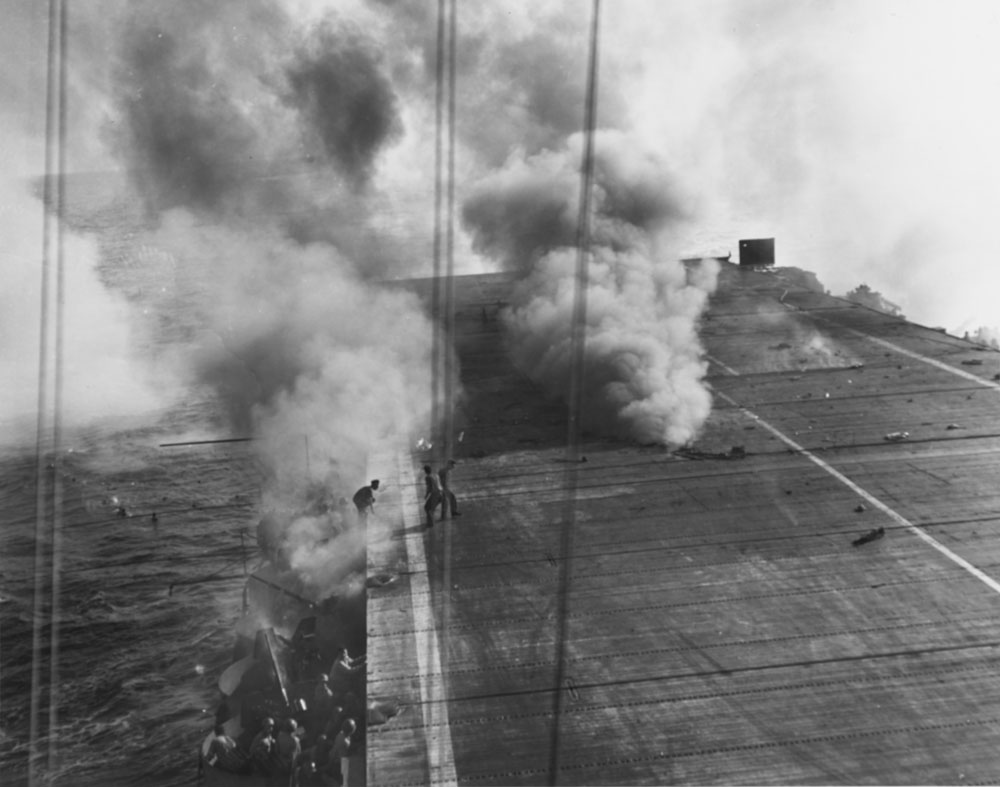
USS Suwannee After Being Hit by Kamikaze Attack
The USS Suwannee after being hit by a kamikaze attack.

USS Kitkun Bay Prepares to Launch Planes as USS White Plains Takes Japanese Fire in Background
Planes preparing to launch from the USS Kitkun Bay while the USS White Plains is taking Japanese fire in the background.


USS Princeton After Being Hit with Japanese Bomb
This USS Princeton after it was hit by Japanese bombs.

Japanese Battleship Nagato Firing, and Taking Fire
The Japanese battleship Nagato firing while being fired.

Japanese Forces in the Philippines
Description of souvenirs Allied victors seized at the surrender of Japanese forces.

The Philippine Expeditionary Force [translated]
The Philippines Expeditionary Force was produced to commemorate the victory over American forces in the Phillipines. It features numerous photographs documenting the Japanese Army's triump, may images highlighting American military commanders.

Type 95 Shin Gunto [New Military Sword]
Type 95 Shin Gunto sword was an issued saber for NCOs and officers of the Japanese Army.

Order of the Rising Sun, 6th Class
The Order of the Rising Sun was the first of Japan's official orders, established in 1875. It has nine classes, the highest being the 1st Class Rising Sun Order of the Paulownia Flowers.

Order of the Rising Sun, 7th Class
The Order of the Rising Sun was the first of Japan's official orders, established in 1875. It has nine classes, the highest being the 1st Class Rising Sun Order of the Paulownia Flowers.

Order of the Rising Sun, 8th Class
The Order of the Rising Sun was the first of Japan's official orders, established in 1875. It has nine classes, the highest being the 1st Class Rising Sun Order of the Paulownia Flowers.

Showa Enthronement Medal
Showa Enthronement Medal was issued to participants to the enthronement ceremony of Emperor Hirohito in 1928.

Navy Correspondence Proficiency Badge, 2nd Class
The Navy Correspondence Proficiency Badge, 2nd Class was awarded to Imperial Japanese sailors that passed tests in communications.

Luzon
The Battle of Luzon was the second phase of MacArthur's campaign to retake the Philippines took place on January 9, 1945, as the 6th Army landed at Lingayen Gulf on the northern island of Luzon.

Coming Ashore at Lingayen Bay
US troops successfully landing on an island in the Philippines
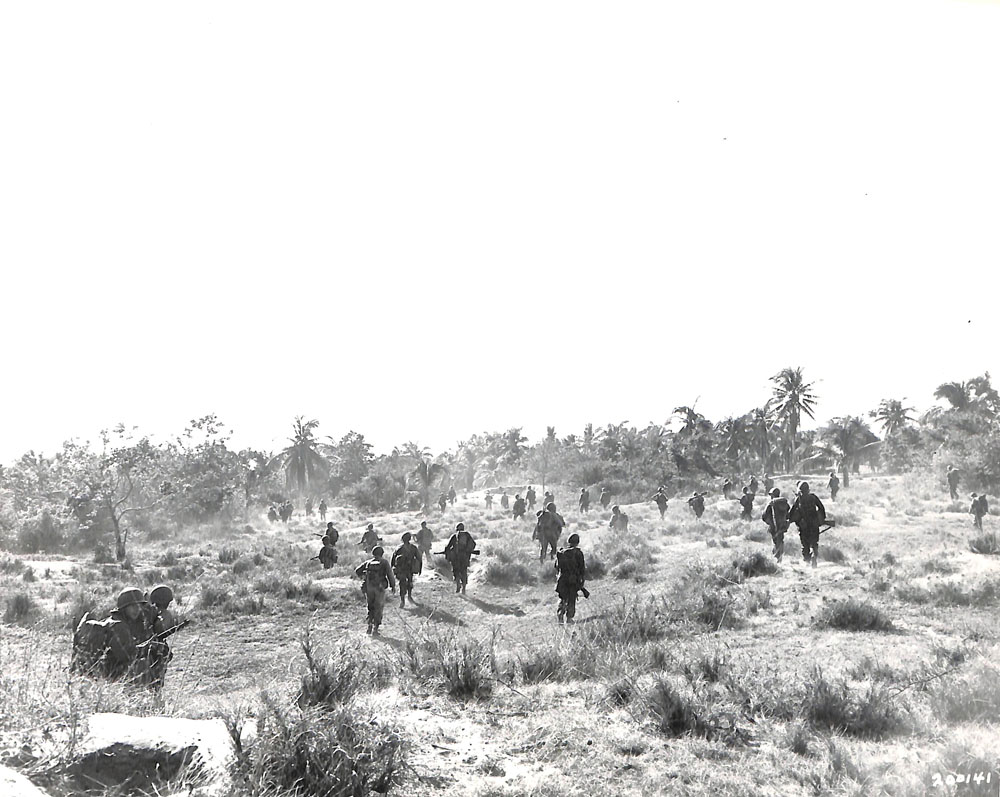
American Troops Move Inland on Luzon
American troops moving inland on the island of Luzon in the Philippines.

Tank Moving Through Destroyed Manila
American tank moving through destroyed Manila, which was all but destroyed by the fighting to liberate it.

Destroyed Post Office Building Framed with Debris
Destroyed post office building in Manila during the battle for liberating the city from Japanese occupation.

Troops Walking Through Destroyed Manila
American troops walking through destroyed Manilla in the Philippines.
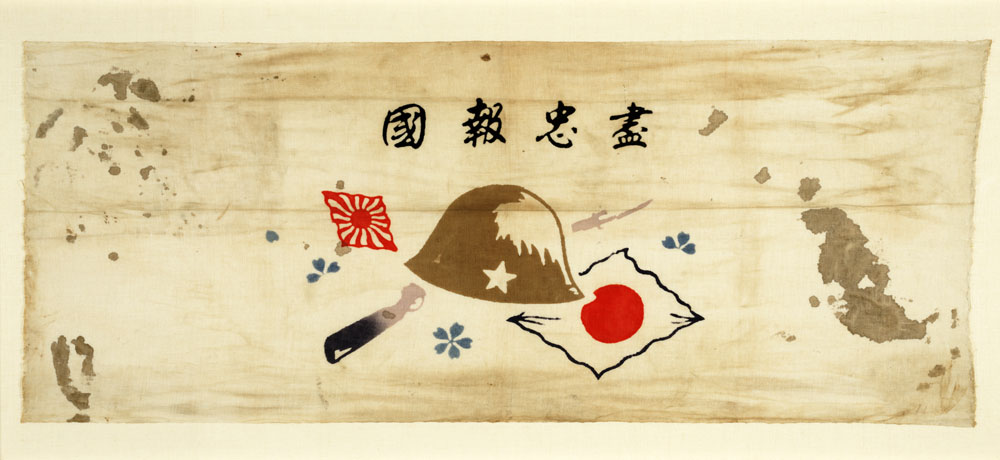
Japanese Trophy flag "Jin, chuu, hou, koku"
Japanese Trophy flag that is given to friends or family members who were deploying to war.

Combat Engineers-- Under Fire by Frank J. Sackton
Map of the roads, sites and bridges created by engineers for US military. Engineers were fundamental to U.S. progress on the island; creating roads, removing mine fields, and transporting supplies to troops as they moved through the country.

Soldiers Rest After Making Their Way Inland
American soldiers resting after making their way inland during the Battle of Luzon.

Soldiers Make Their Way Through Village, Luzon
U.S. soldiers making their way through a village on Luzon.


Newspaper Clipping
Newspaper clipping about 1st Lieutenant Robert Eddy being wounded in action


Newspaper Clipping
Newspaper article about 1st Lieutenant Robert Eddy receiving the Bronze Star.

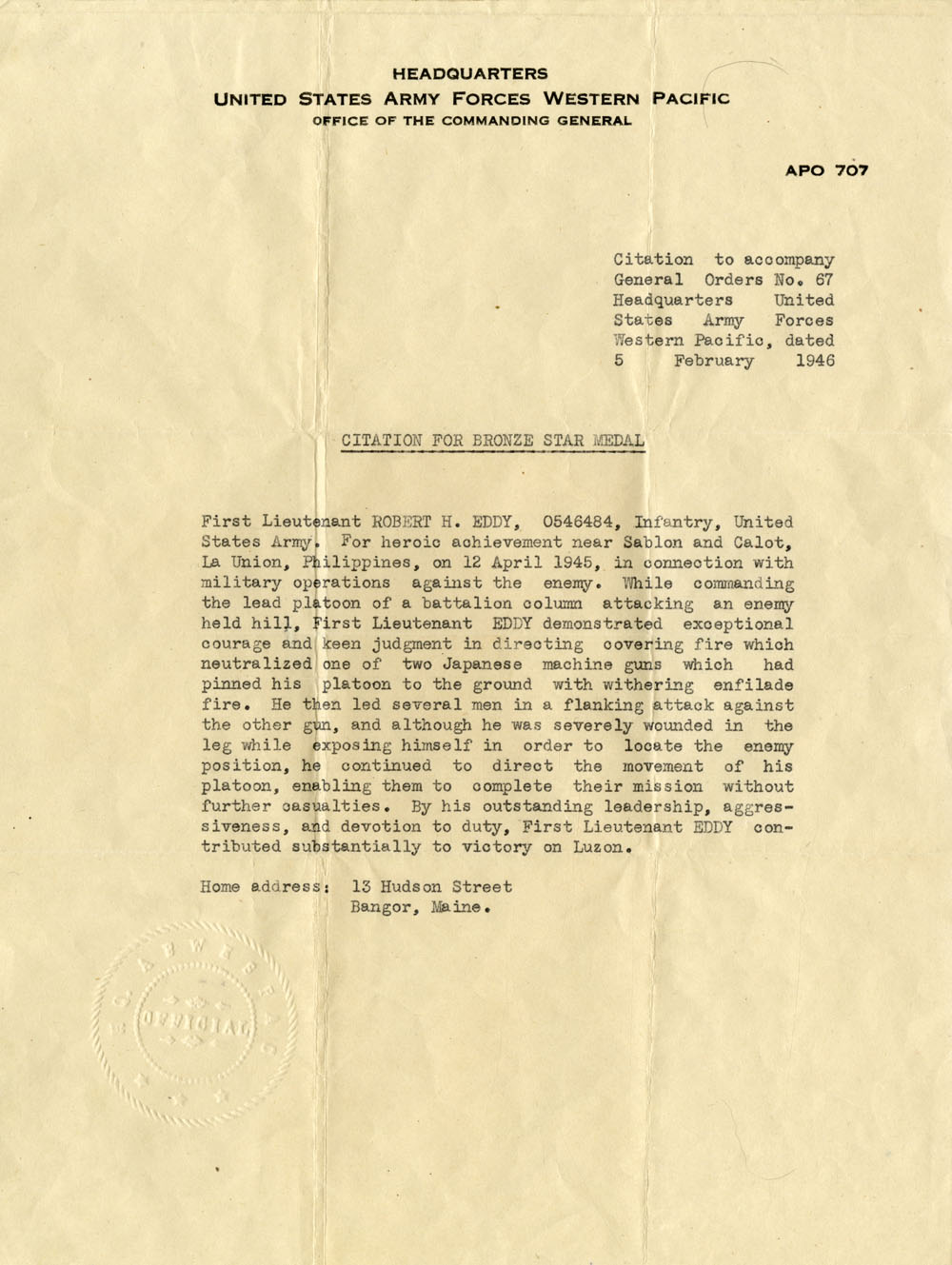

Battle of Iwo Jima
The island of Iwo Jima was essential to the American strategy of taking Japan as it was located almost equidistant from American forces in Guam and the Japanese mainland with airfields from which to stage attacks on the Japanese mainland.

In the Afternoon
The Marines were met with little resistance upon the initial assault of Iwo Jima. Unaware that the full force of the Japanese army was waiting inland, U.S. forces were fatally exposed as they began their push to take the island’s airfields.

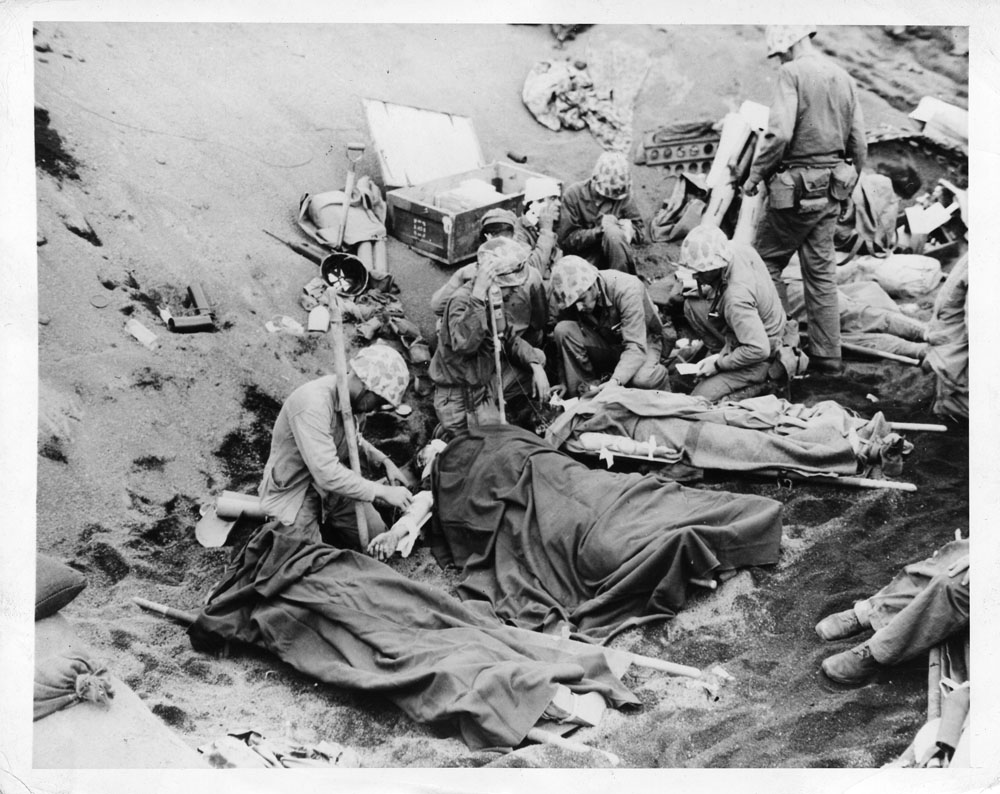
Marine Casualties on Iwo Jima
Wounded Marines being attended to at an Aid Station on Iwo Jima.

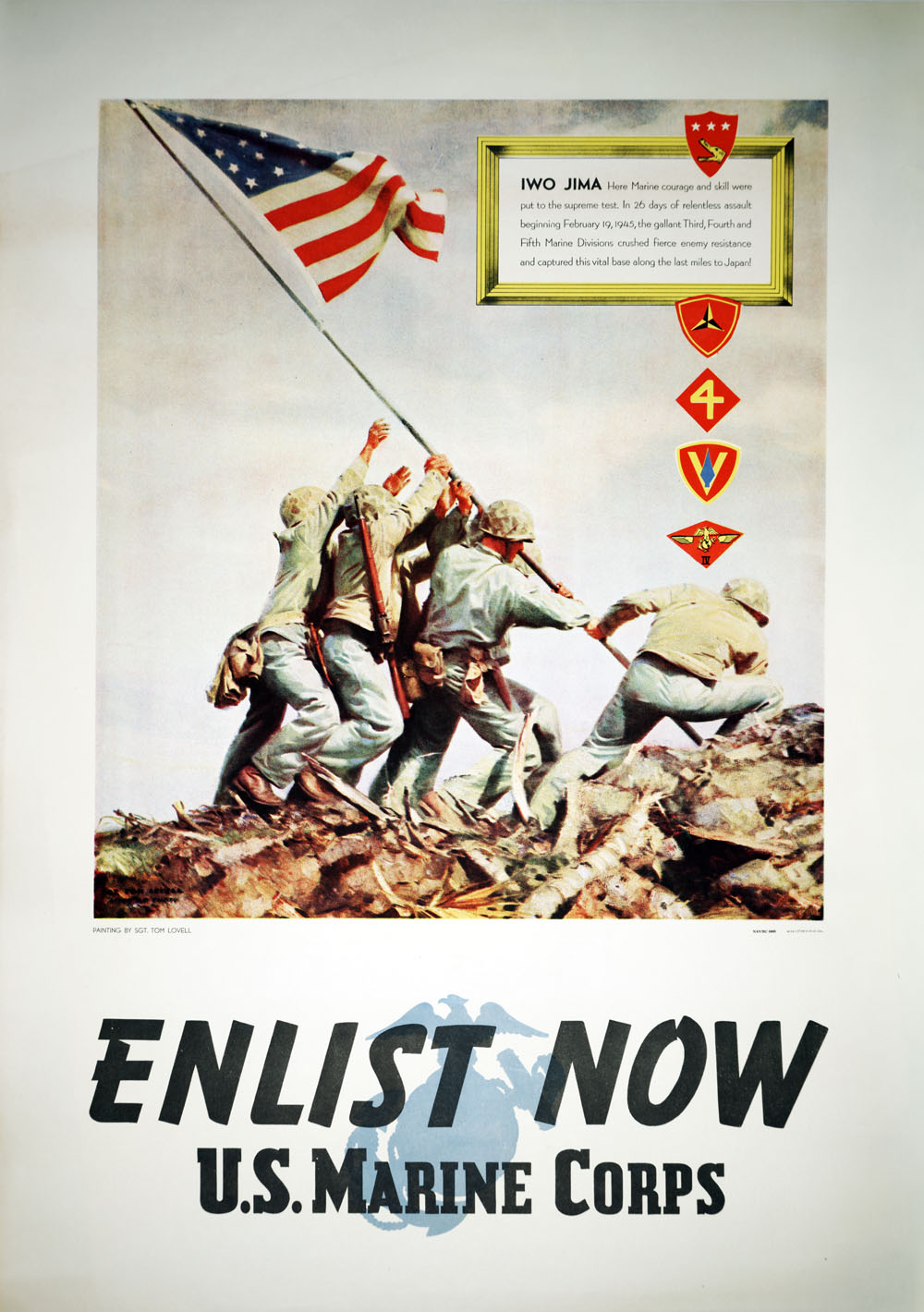
Enlist Now: US Marine Corps
Enlist Now : US Marines poster features Marines raising the American flag on Iwo Jima.

Marines Hold Captured Flag on Iwo Jima

Battle of Okinawa
The last major land battle of World War II began as U.S. forces came ashore at Okinawa on April 1, 1945. Under the command of Admiral Nimitz, Operation Iceberg commenced as a combined force of Army, Navy, and Marine Corps units began their assault on the shores of Okinawa.

Army-Navy Show at Okinawa
US troops aboard amphibious crafts approaching the beaches of Okinawa.



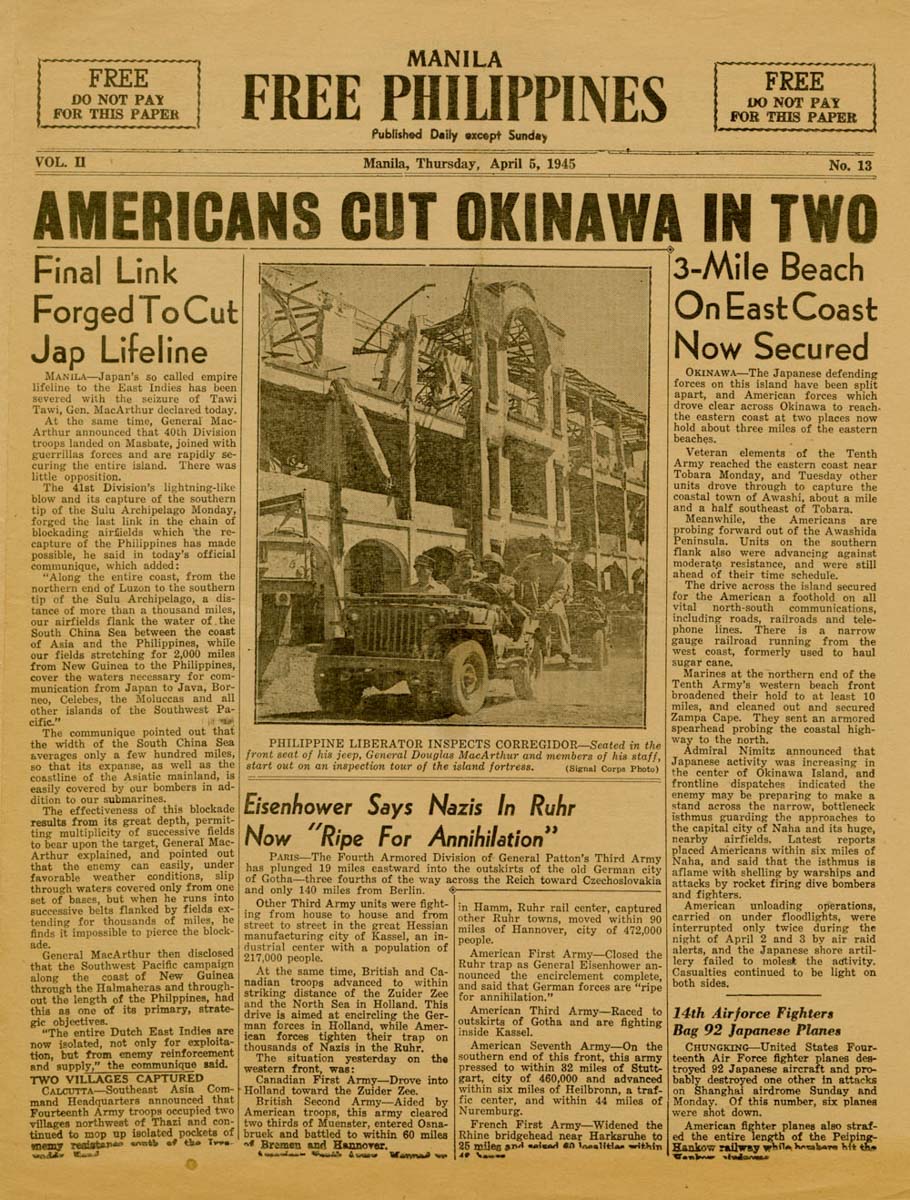
"Americans Cut Okinawa in Two"
The Manila Free Philippines, the English-language newspaper of the American occupied Philippines.

Assault
The US Marines of the 1st Division beginning an offensive to overtake Shuri Castle.


All Done in After “Big Apple” Battle
Exhausted from the rigos of close-combat on Okinawa, Marines and soldiers rest.

Air campaign against Japanese Mainland
The American decision to begin strategic bombings against the Japanese mainland began in mid-1944, as the Marianas campaign was underway to gain access to the island’s strategic airfields.


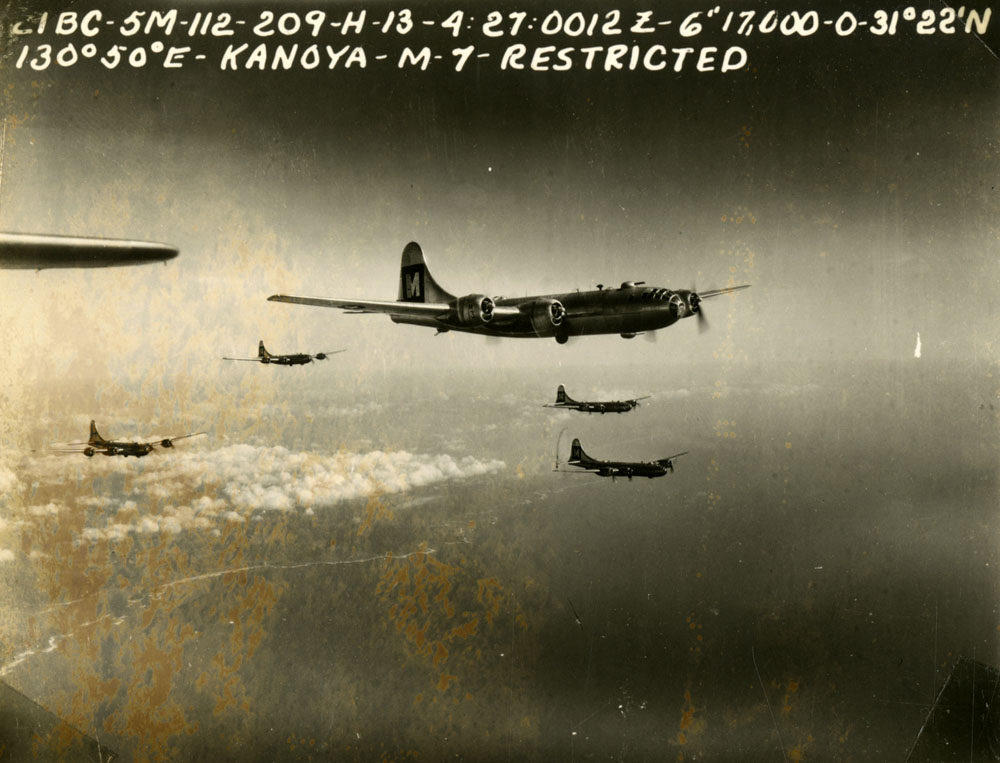

B-29 Bomber Releasing Incendiary Bombs Over Japan
Sky full of B-29 bombers releasing bombs over Japan.


“That’s the Spot to Hit!”
Admiral Nimitz pointing to the Japanese capital of Tokyo as the target of American military forces.
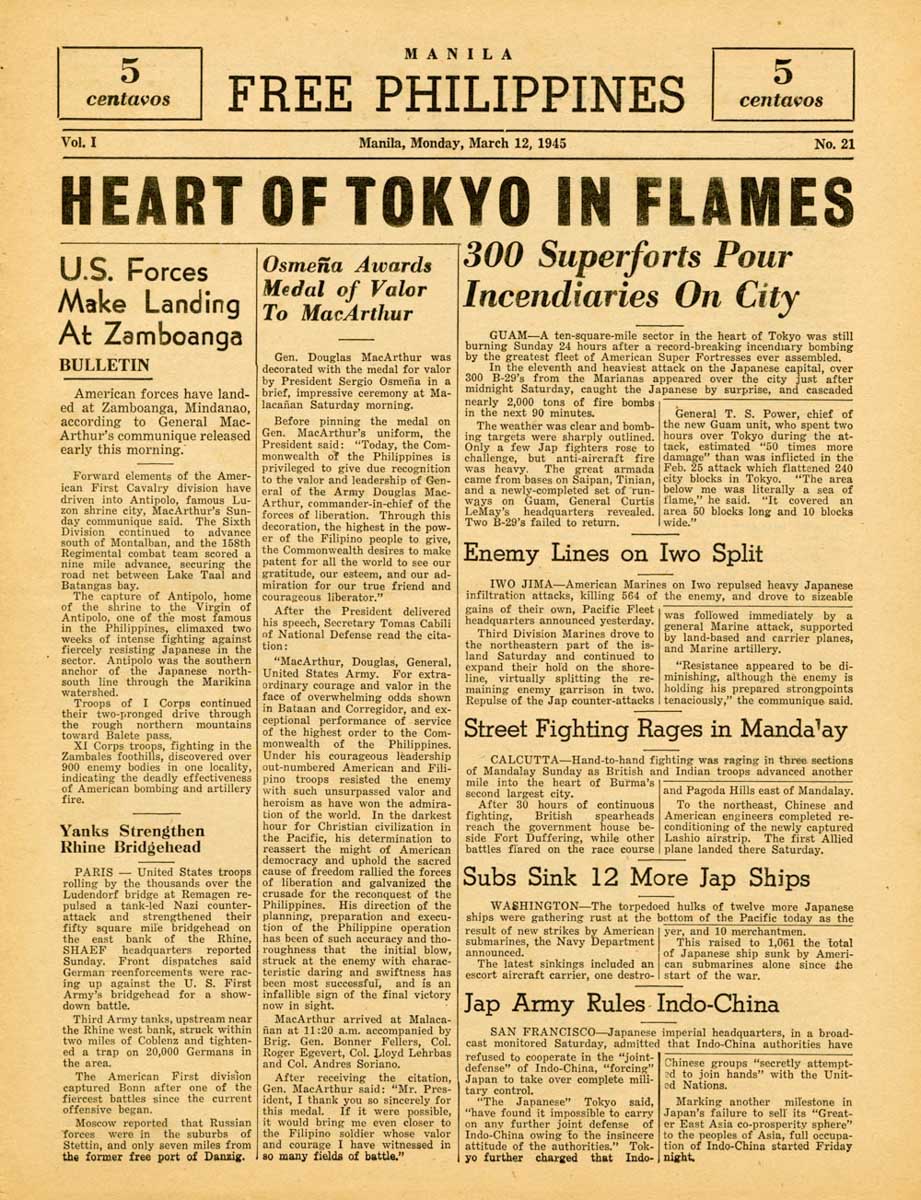



Nakajima Aircraft – Musashino Plant Chart
Map of the aircraft-part-producing Nakajima Musashino Plant near Tokyo.
Before and After: Bombing the Nakajima Musashino Plant
Carrying a single 2,000 pound general purpose bomb, the raid came just two days after the first atomic bomb had been dropped.

Bombardier's Flimsy-Nakajima Musashino Plant
Bombers' flimsy of the target Musashino plant on the outskirts of Toyko.
Smoke Rising from Osaka in Two Frames
The aerial bombardment of Japan was devastating to the Japanese mainland. By burning homes, businesses, and hospitals it impacted every facet of everyday life for the Japanese; where they slept, ate, worked, and acquired clothing and medicine. As the second largest city in Japan, Osaka was an important industrial center, producing large quantities of steel and other heavy metal enterprises for the war effort. It was bombed more than a dozen times over the course of 1945.
Supplies Dropped on POW Camps in Japan
With the Japanese surrender official, B-29 bombers shifted their focus to providing aid for the thousands of Allied POWs held in Japan. Often identified only by the “PW” written in the camps themselves, once located, the bombers completed numerous missions to bring much needed food and clothing to the prisoners.



Distinguished Flying Cross
The Distinguished Flying Cross medal belonging to Charles Vann.

1st Lt. Charles W. Vyhnanek Receives the Distinguished Flying Cross
1st Lieutenant Charles W Vyhnanek receiving the Distinguished Flying Cross medal.
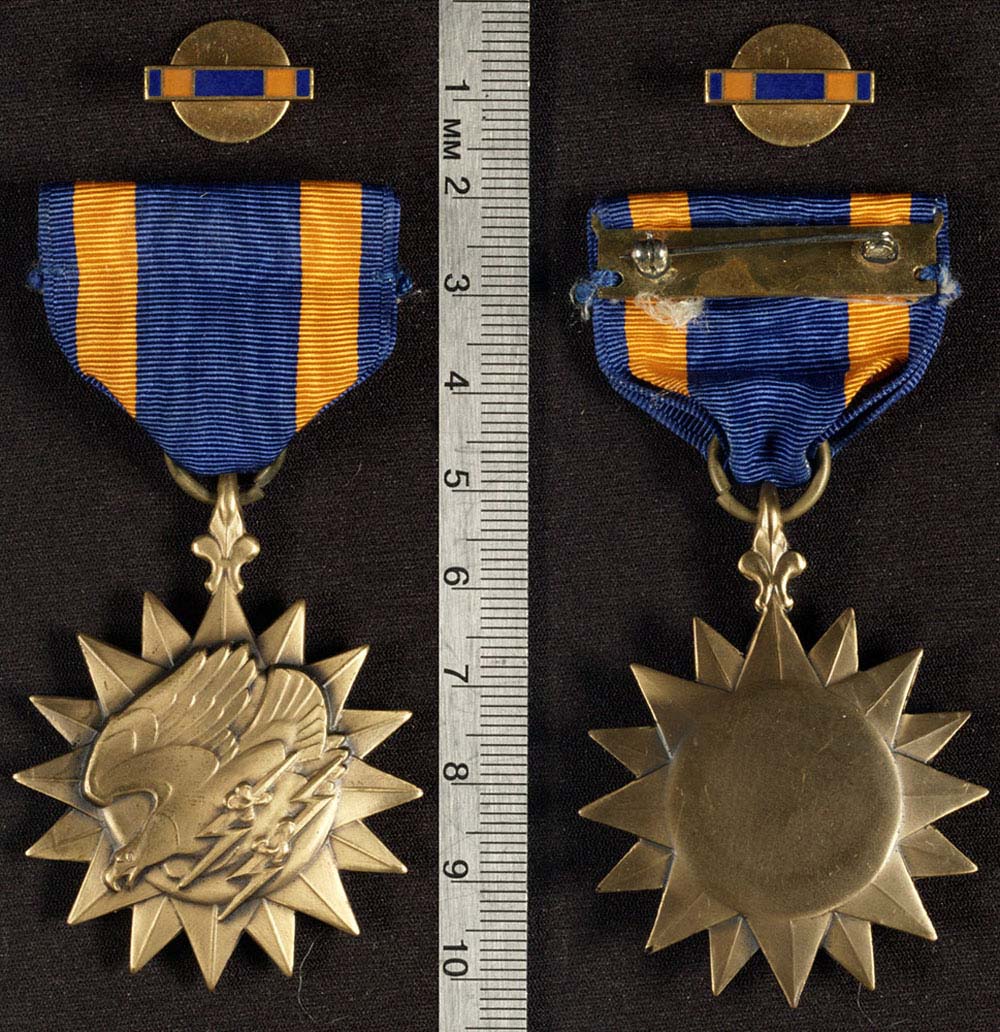
Air Medal
The Air Medal was awards to Lt. Vyhnanek for his achievement as a bombardier over the course of his 26 combat missions.

Preset Dropping Angle Scale
This angled calculator was a piece of standard issue equipment and was included in the "Bombardiers Kit".

“The Nose”
This illustration depicts the view looking out of the nose of a B-29th, highlighting a low altitude night raids.
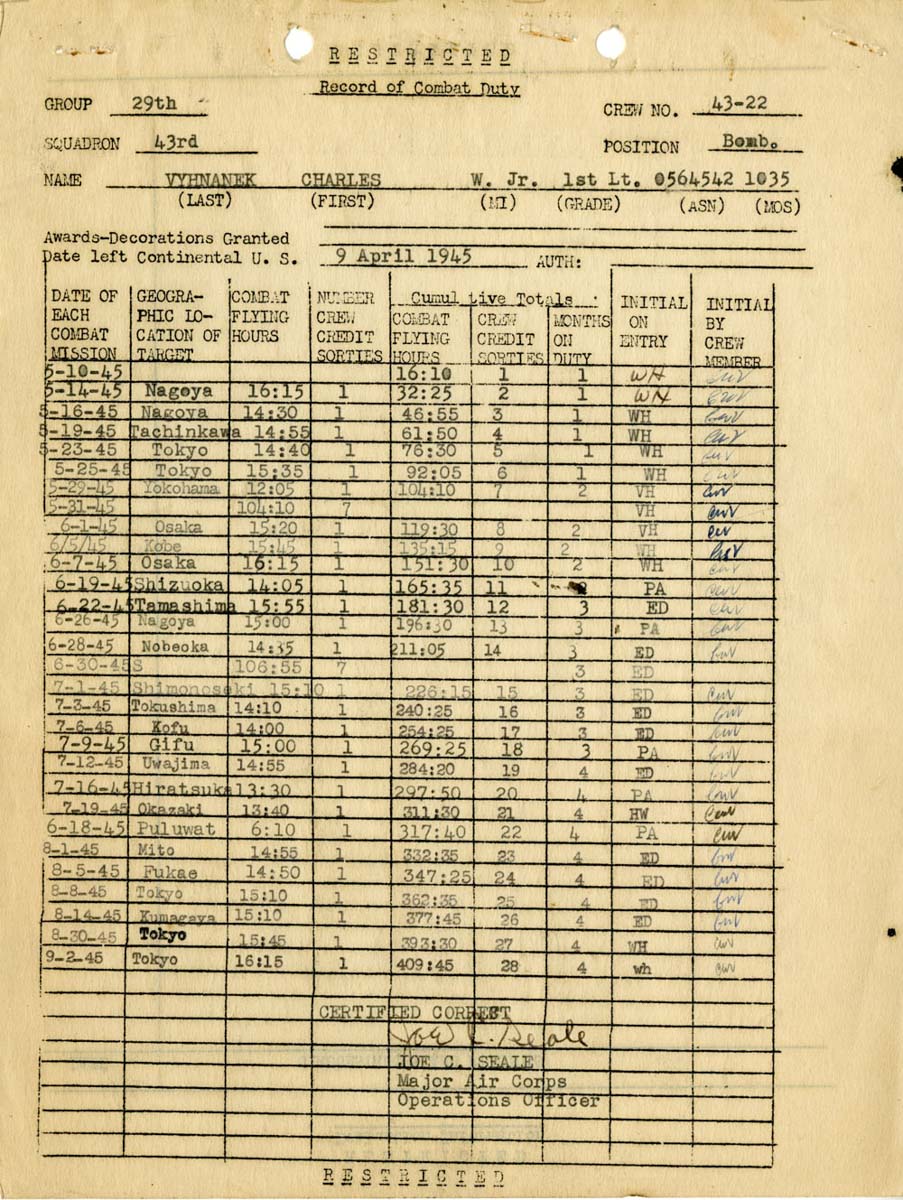
Record of Combat Duty
This record of combat duty lists each flight Lt. Vyhnanek's made while a bombardier with the 43rd Squadron, 29th Bombardment Group.
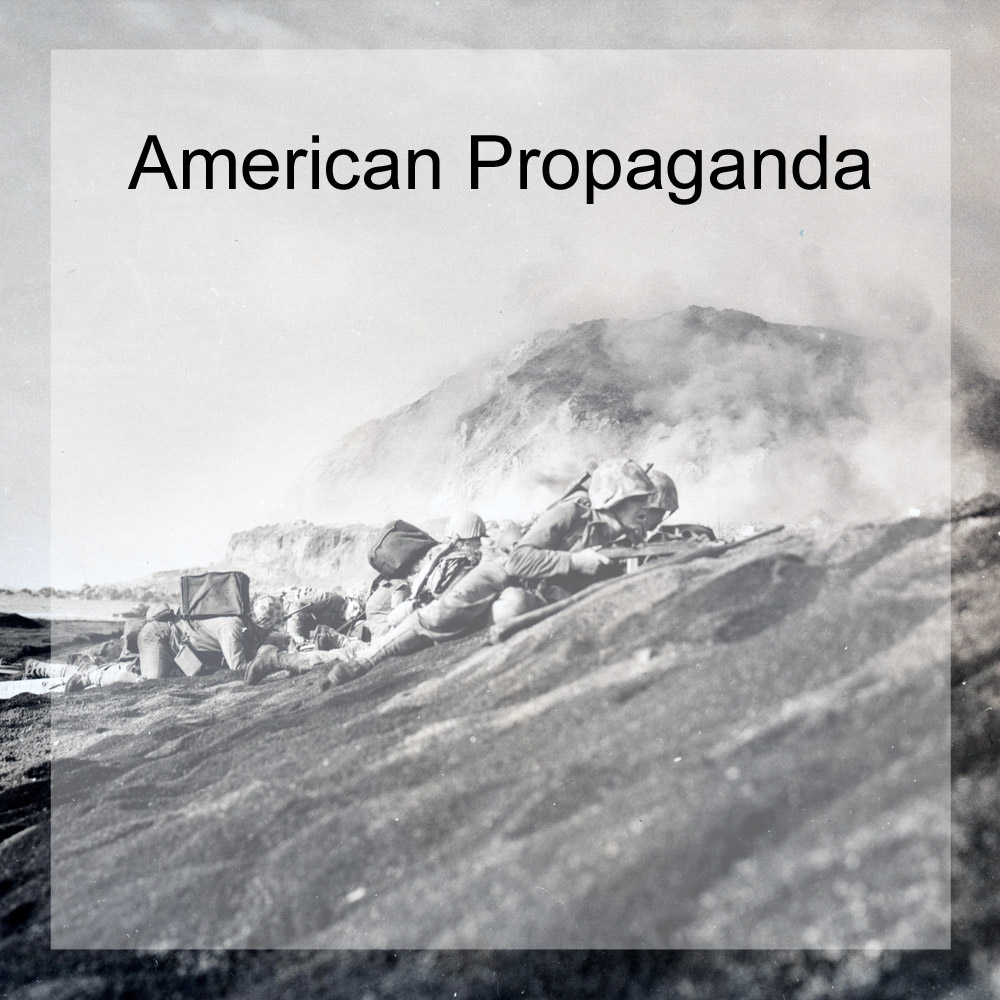
American Propaganda
An important aspect of the Allied bombing campaign of Japan was the dropping of millions of propaganda leaflets. Depicting airplanes, bombs, and the cities to be bombed, the leaflets encouraged Japanese civilians to flee while indicating that the bombing was not aimed at them but at war industries, and that their militaristic government was to blame for their suffering. Additional leaflets encouraged Japanese soldiers and sailors to throw down their weapons and surrender to American forces.

“The Hour is Drawing Near!”
A clock themed leaflet, with an implicit message that time is running out.

“Warning for Civilians”
Leaflet illustrating the destructive nature of American bombers.

“Attention Japanese Civilians”
Propaganda leaflet that depicts five B-29s dropping their bombs over Japan, also featuring the names of twelve cities, many of which would be bombed in the coming days.

“I Cease Resistance”
Intended for Japanese soldiers fighting across the Pacific, these leaflets featured messages that encouraged forces in particular locations to surrender in the face of overwhelming odds. This leaflet was intended for Japanese soldiers fighting on Luzon, in the Philippines, and would guarantee soldiers safe passage if they dropped their weapons and surrendered to American forces.

Dropping the Atomic Bombs
Following the months long bombing campaign against the mainland, and with a Japanese rejection of unconditional surrender, on August 6, 1945 Colonel Paul Tibbets flew the Enola Gay over the city of Hiroshima, dropping the first atomic bomb at 8:15am.

Pictogram Showing the Relative Power or the Atomic Bomb
Pictogram showing the power of the atomic bomb in comparison to bombs on B-29s and TNT.
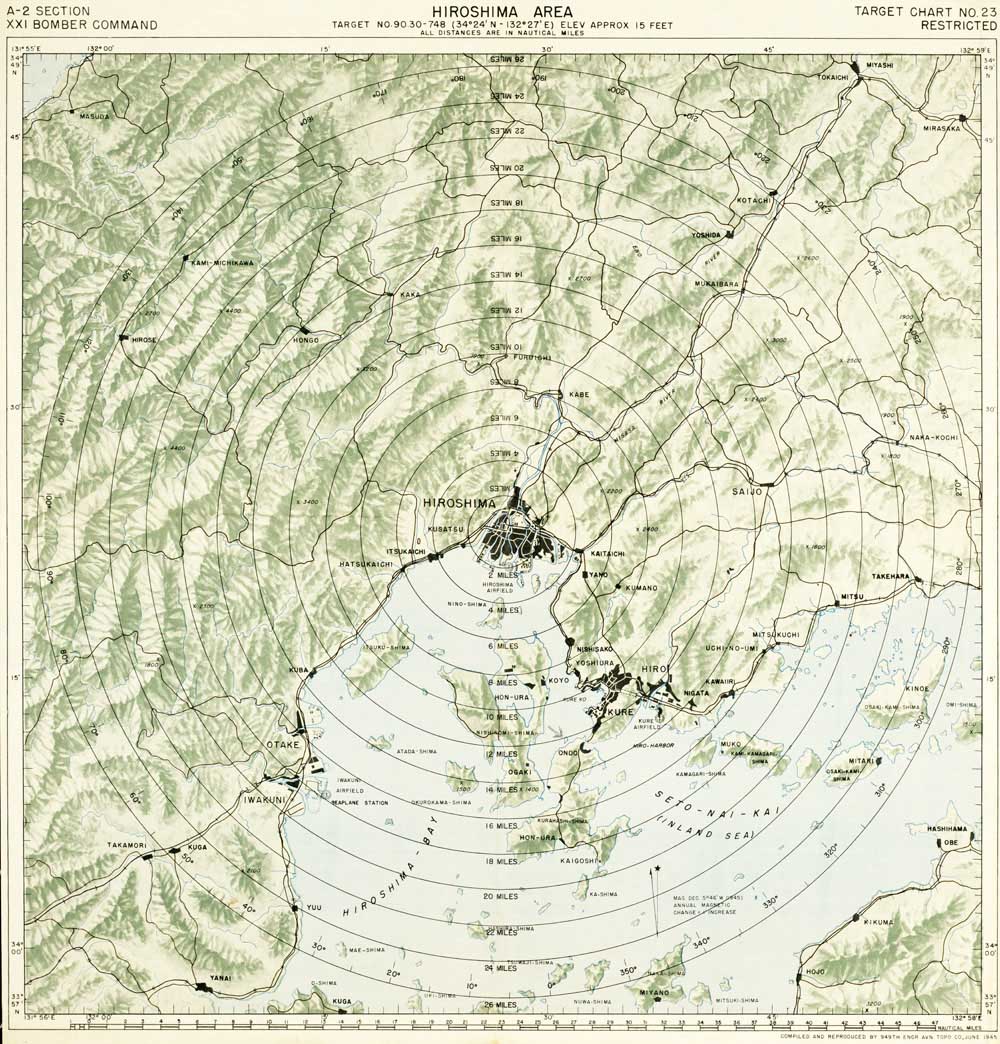
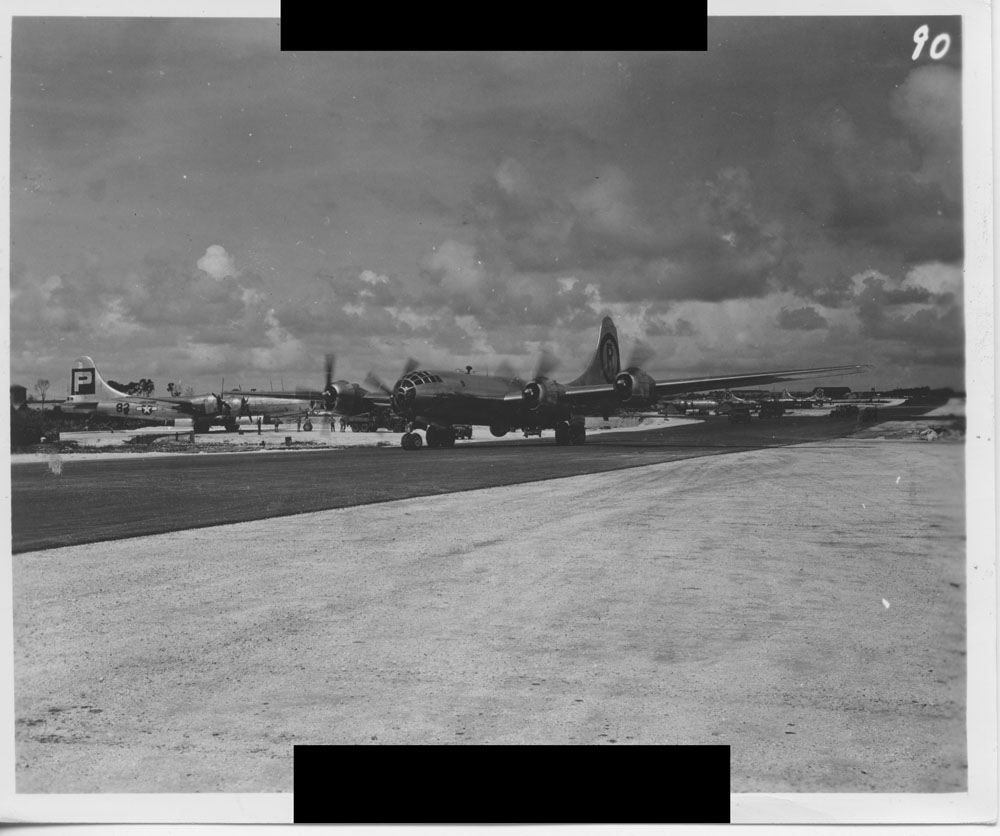
Enola Gay Returns Home after Strike at Hiroshima
Enola Gay returning after strike at Hiroshima. Enola Gay was the first aircraft to drop the atomic bomb.

Smoke Column over Hiroshima, Japan
Photo of smoke column over Hiroshima, Japan after the atomic bomb was dropped.

Hiroshima after the Atomic Bomb
Burned out fire truck in Hiroshima, Japan after the atomic bomb was dropped.

Smoke Column over Nagasaki, Japan
Smoke column over Nagasaki, Japan after the atomic bomb was dropped.

Nagasaki after the Atomic Bomb
Nagasaki landscape after the atomic bomb was dropped on it.

Surrender
The United States began the occupation of Japan at the end of August, with the Japanese formally surrendering aboard USS Missouri in Tokyo Harbor on September 2, 1945.

Japanese Delegates Arrive to Sign Surrender
Japanese delegates arriving to the USS Missouri to sign surrender.

Japanese Delegates Sign Surrender Document
Japanese delegates sign surrender documents aboard the USS Missouri.

Admiral Nimitz Signs the Surrender Aboard USS Missouri
Photo of Admiral Nimitz signing the surrender of Japan aboard the USS Missouri.


Surrender in Majuro
American forces captured the Marshall Islands in April 1944, taking the Japanese garrison as POWs. With the official surrender in September 1945, U.S. forces conducted a formal ceremony of surrender on Majuro before repatriating Japanese forces to the mainland.

Japanese Naval Forces Await Surrender on Majuro, Marshall Islands
Japanese naval forces awaiting surrender on Majuro, Marshall Islands.

American Sailors March to Surrender Ceremony
American sailors marching to surrender ceremony on Marshall Islands.

Japanese Naval Officers Salute during Surrender Ceremonies
Japanese naval officers salute during surrender ceremony on Marshall Islands.
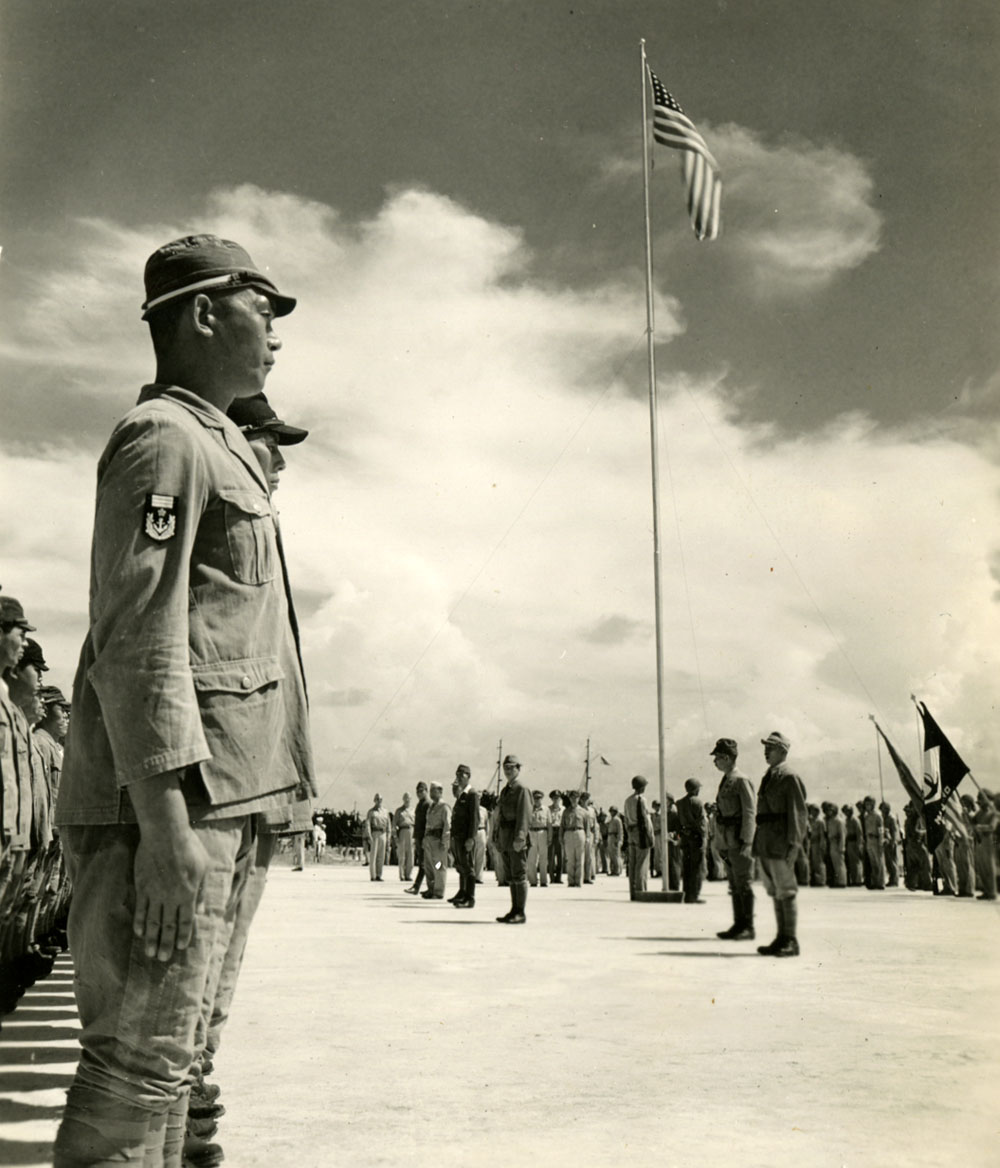
Japanese Sailors Watch as American Flag is Raised
Japanese sailors watch as the American flag is raised during the surrender ceremony at Marshall Islands.

Surrender in the Philippines
With the formal announcement of surrender by Emperor Hirohito, American forces attempted to notify Japanese forces throughout the Pacific that the war was over. On Luzon, General Yamashita still commanded nearly 40,000 battle-weary Japanese soldiers and civilians. After numerous efforts to contact the General, U.S. commanders were able to arrange a meeting with Yamashita in Baguio, where, on September 3, 1945, he surrendered the remaining Japanese forces of the Philippines. Following his surrender, subordinate commanders began turning themselves in to U.S. forces across the Philippines. Lt. Eddy and Company C of the 19th Infantry Regiment were present in Aparri when Japanese forces surrendered themselves.

American Soldiers Lead Japanese Soldiers to Surrender
American soldiers leading Japanese soldiers to surrender.

Japanese Soldiers Carry White Flag to American Forces
Japanese soldiers carrying the white flag of surrender to American forces.

Japanese Soldiers Await Surrender
Japanese soldiers wait to surrender to American forces.

Japanese Forces Surrender to the 129th Infantry Regiment, 37th Infantry Division
Japanese forces surrendering to the 129th Infantry Regiment, 37th Infantry Division.

Japanese Soldiers Lay Down Their Arms
Japanese soldiers lay down their weapons to American forces.
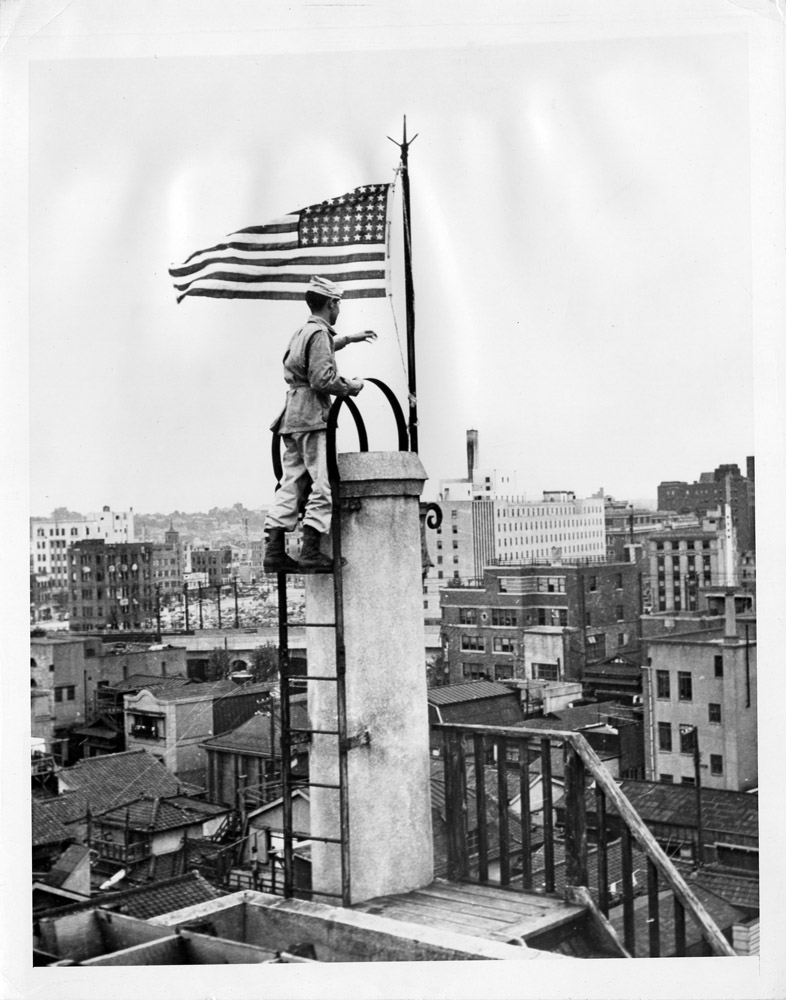
Stars and Stripes Over Tokyo
Lt. Bernard “Bud” Stapleton raising an American flag over the Nippon News building in downtown Tokyo.
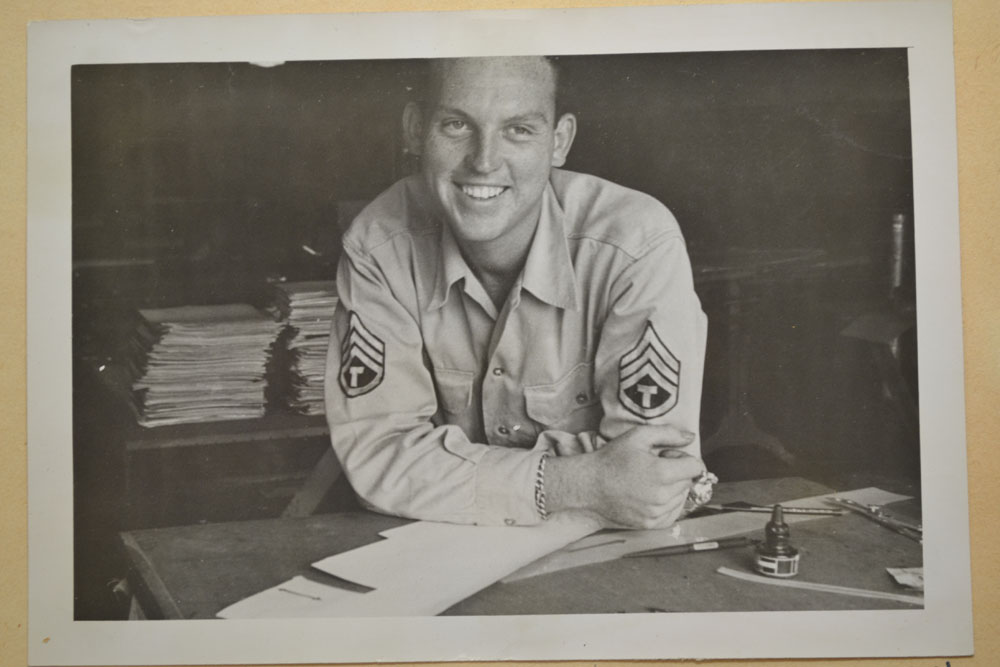
Jack V. Sewell at His Desk
Jack V. Sewell served as a Photo Intelligence and Military Intelligence Technician in World War II. He deployed to the Pacific as a Technical Sergeant with the 6th Army from July 1944 to January 1946.
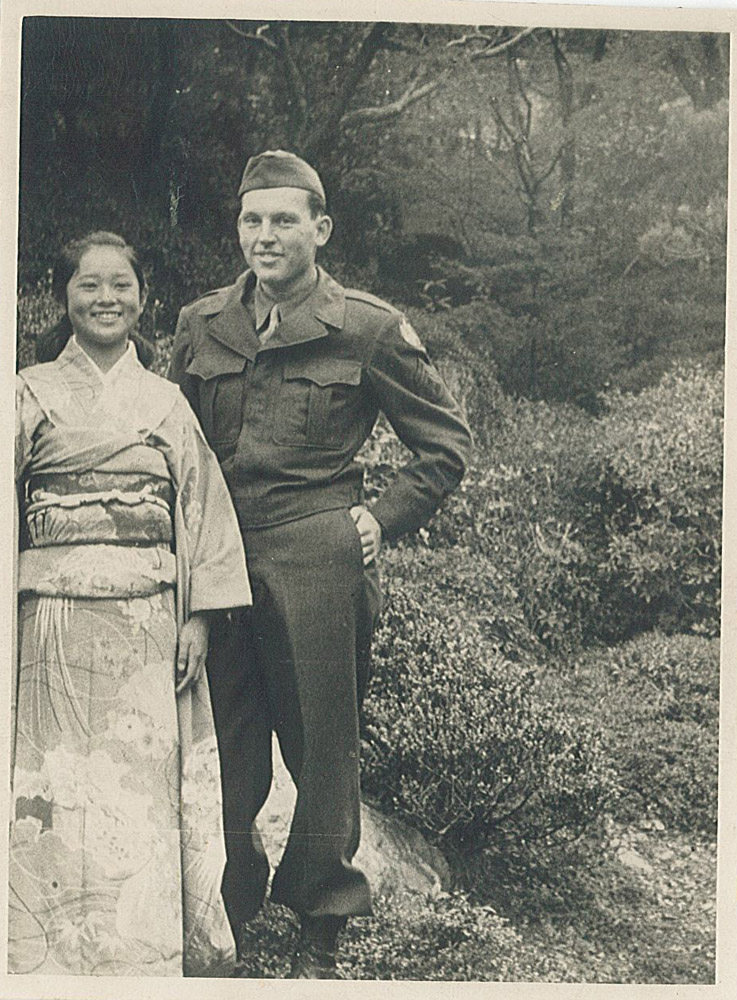
Jack V. Sewell and "Dimples"
Jack V. Sewell and “Dimples,” a nickname given to Toshiko by Sewell and his friends, was the daughter of a prominent Japanese family.

Jack V. Sewell and "Snooks"
Jack V. Sewell with the young daughter of a prominent Japanese family.

Page from Jack Sewell's Scrapbook
This page from Jack V. Sewell's scrapbook that documents the distruction that Osaka faced.

Introduction to the European Theater
Introduction to the European Theater during World War II.

Allied Advance into Germany, Fall 1944
Following the successful Normandy campaign in the summer of 1944, the Allies moved rapidly through France, liberating Paris on August 25. This advance would grind to a halt in the fall as supply lines were stretched thin and Allied forces approached the heavily defended Siegfried Line at the German border. In late September, General Courtney Hodges’ First Army engaged in fighting around the city of Aachen, Germany as part of the Allied plan to occupy the industrialized Ruhr Basin in northwest Germany.

GI Machine Gun Crew Fighting in the Streets of Aachen
As U.S. forces surrounded the city of Aachen, the 26th Infantry Regiment began the offensive to take the city. Operating with only two battalions and a few tanks, the 26th attacked the city and its 10,000 defenders on October 13, 1944. They fought house to house until the city was finally taken on October 21; the first German city to fall to American forces.

A Procession of German Prisoners Captured with the Fall of Aachen
As U.S. forces surrounded the city of Aachen, the 26th Infantry Regiment began the offensive to take the city. Operating with only two battalions and a few tanks, the 26th attacked the city and its 10,000 defenders on October 13, 1944. They fought house to house until the city was finally taken on October 21; the first German city to fall to American forces.

22nd Infantry Regiment in the Hürtgen Forest near Grosshau, Germany
The 22nd Infantry Regiment entered the Hürtgen Forest on November 16, 1944 as one of two infantry regiments representing the 4th Infantry Division. They fought for 18 days gaining 6000 yards of territory before being relieved on Dec 3. In total, the men of the 22nd Infantry Division suffered 2,773 casualties, losing nearly 60 percent of their officers and 54 percent of their men.

22nd Infantry Regiment Mortar Crew Near the Town of Grosshau in the Hürtgen Forest
An 81mm mortar crew from the 22nd Infantry Regiment fires from the rubble of a village in support of rifle companies holding off a German counterattack at Grosshau, December 1, 1944.

110th Infantry Regiment, 28th Infantry Division Moves Through the Hürtgen Forest near Vossenack, Germany
The 28th Infantry Division relieved the 9th Infantry Division in the Hürtgen Forest in mid-October. They attacked the town of Schmidt in early November, with the 110th Regiment ordered to clear the woods near the Kall River. The 28th Division sustained heavy casualties in the Hürtgen and would later play a significant role in delaying the German advance in the Ardennes.

Battle of the Bulge, December 1944 – January 1945
The Battle of the Bulge was one of the greatest American battles of World War II. Though supported by the British and Canadians, American soldiers bore the brunt of Hitler’s desperate winter offensive, suffering over 80,000 casualties. The Germans suffered between 80,000-100,000 casualties and had two fewer panzer armies on the Eastern Front to defend against the Soviet offensive. The Allied victory in the Ardennes set the stage for the invasion of Germany, a campaign that ended with Germany’s surrender on May 8, 1945.

The Battle of the Bulge: Dec 16 & Dec 25, 1944
These maps show the front line just prior to the German offensive, and the point at which the German army surrounds the city of Bastogne. The northernmost section of the map shows the buildup of forces in an area where the Allies had breached the West Wall. To the south, Allied forces are spread incredibly thin with an 80 mile section occupied by just three Infantry divisions. The German offensive against this vulnerable area would ultimately form the namesake bulge in the line, as seen in the second image.

SSgt John F. O’Brien in a Foxhole in the Monschau Area of Germany
SSgt. John F. O'Brien in a foxhole in the Monschau in Germany.

Malmedy Massacre
On December 17, shortly after the German offensive began, a group from the 6th Panzer Army captured and killed 68 American soldiers near the village of Honsfield. Later that afternoon, they captured another 100 soldiers from the 285th Field Artillery near Malmedy and shot them in a nearby field. News of the massacre spread quickly through the ranks and in retaliation many American units adopted a policy of not taking German prisoners.

7th Armored Division at Vielsalm
The 7th Armored Division played an important role in holding the advance of the 5th Panzer Army at St. Vith. Together with the 106th and 28th Infantry divisions, and the 9th Armored Division, they formed a horseshoe-shaped defensive perimeter around the town, aimed at stopping the German advance.

28th Division Band and Quartermaster Company Regroup at Bastogne
After suffering heavily casualties in the Hürtgen Forest, the 28th Infantry Division was moved to the relatively quiet sector near Bastogne to recuperate.

Troops Regrouping in Bastogne
After suffering heavily casualties in the Hürtgen Forest, the 28th Infantry Division was moved to the relatively quiet sector near Bastogne to recuperate.

101st Airborne Receives Air-dropped Supplies During Siege of Bastogne
On the night of December 18, elements of 101st Airborne moved into the town of Bastogne to hold off the German advance and protect the vital road junction there. They were encircled by the enemy on December 21 and for several days resupplying the beleaguered defenders was impossible due to poor weather. The skies cleared on December 23, allowing C-47 planes to air drop desperately needed supplies to the besieged troops.

Bomb Damage in Bastogne, Belgium
For civilians, it was much safer to be in an American-held town than those held by the Germans. German-held towns in the Bulge were subject to intense aerial bombardment from the Allies in advance of a ground attack. Though shelled relentlessly by the Germans during the siege, Bastogne was spared the total devastation of nearby towns like St. Vith and Sainlez which were reduced to rubble by the time Allied forces could liberate them from the Germans.

Members of the 101st Airborne Division as they Move Out of Bastogne, Belgium
Despite being greatly outnumbered and facing heavily armed German forces, the poorly equipped and lightly armed 101st Airborne Division held the city of Bastogne.

101st Engineers Emerge From Woods Following German Counterattack near Wiltz
With German momentum in Belgium stalling in the last days of December, the Allies began a slow, cautious push to drive the Germans back across the Siegfried line, recapturing what was left of towns like St. Vith, Wiltz, and Houffalize.

7th Armored Division near St. Vith
With German momentum in Belgium stalling in the last days of December, the Allies began a slow, cautious push to drive the Germans back across the Siegfried line, recapturing what was left of towns like St. Vith, Wiltz, and Houffalize.

Soldiers of the 11th Armored Division Run Through a Smoke-Filled Street in Wernberg, Germany
The Allied victory in the Battle of the Bulge set the stage for a large-scale breach of the Siegfried Line and the invasion of Germany.

American Patrol on the Outskirts of Beffe, Belgium
A Cavalry Squadron reconnaissance is attacked by German snipers on the outskirts of the newly captured town of Beffe, Belgium.

Liberation
After defeating the German army at the Battle of the Bulge, American forces continued their push east into Germany, crossing the Rhine River in mid-March. Within days, seven American divisions were in Germany making the final push to end the war. As they fought the retreating German army into the crumbling Reich, American forces also began to encounter the remnants and survivors of the Nazi’s brutal concentration camp system.

Ohrdruf
The American’s first encounter with Nazi Germany’s concentration camps occurred at Ohrdruf, a forced labor camp that served as a subcamp of the larger camp at Buchenwald. When Americans entered the camp, the few survivors they encountered were of nearly every European nationality, torn from their homes to serve as laborers for Nazi military projects.

View of Prisoner Barracks in the Newly Liberated Ohrdruf Concentration Camp
The American’s first encounter with Nazi Germany’s concentration camps occurred at Ohrdruf, a forced labor camp that served as a subcamp of the larger camp at Buchenwald. When Americans entered the camp, the few survivors they encountered were of nearly every European nationality, torn from their homes to serve as laborers for Nazi military projects.

American Soldiers on an Inspection Tour of the Newly Liberated Ohrdruf Concentration Camp
The American’s first encounter with Nazi Germany’s concentration camps occurred at Ohrdruf, a forced labor camp that served as a subcamp of the larger camp at Buchenwald. When Americans entered the camp, the few survivors they encountered were of nearly every European nationality, torn from their homes to serve as laborers for Nazi military projects.

American Soldiers View a Gallows Erected Between Rows of Barracks in the Ohrdruf Concentration Camp
The American’s first encounter with Nazi Germany’s concentration camps occurred at Ohrdruf, a forced labor camp that served as a subcamp of the larger camp at Buchenwald. When Americans entered the camp, the few survivors they encountered were of nearly every European nationality, torn from their homes to serve as laborers for Nazi military projects.

Ohrdruf Concentration Camp Survivors Reenact Torture Scenes while an American Soldier Looks On
The American’s first encounter with Nazi Germany’s concentration camps occurred at Ohrdruf, a forced labor camp that served as a subcamp of the larger camp at Buchenwald. When Americans entered the camp, the few survivors they encountered were of nearly every European nationality, torn from their homes to serve as laborers for Nazi military projects.

Generals Eisenhower, Patton, and Bradley Inspect the Newly Liberated Ohrdruf Concentration Camp
Generals Eisenhower, Patton and Bradley visited the camp a week after its discovery, noting that previous reports about the atrocities committed by the Nazis were an understatement, clearly evidenced by the scene they witnessed at Ohrdruf.

American Soldiers Number Grave Markers for Dead Prisoners Found in Ohrdruf Concentration Camp
American soldiers numbering grave markers for dead prisoners.

Dora-Mittelbau
The 3rd Armored Division discovered the Dora-Mittelbau concentration camp on April 11, 1945. The camp, located near the town of Nordhausen, was – like Ohrdruf – originally created as a subcamp of Buchenwald in order to produce the V-1 and V-2 rockets.
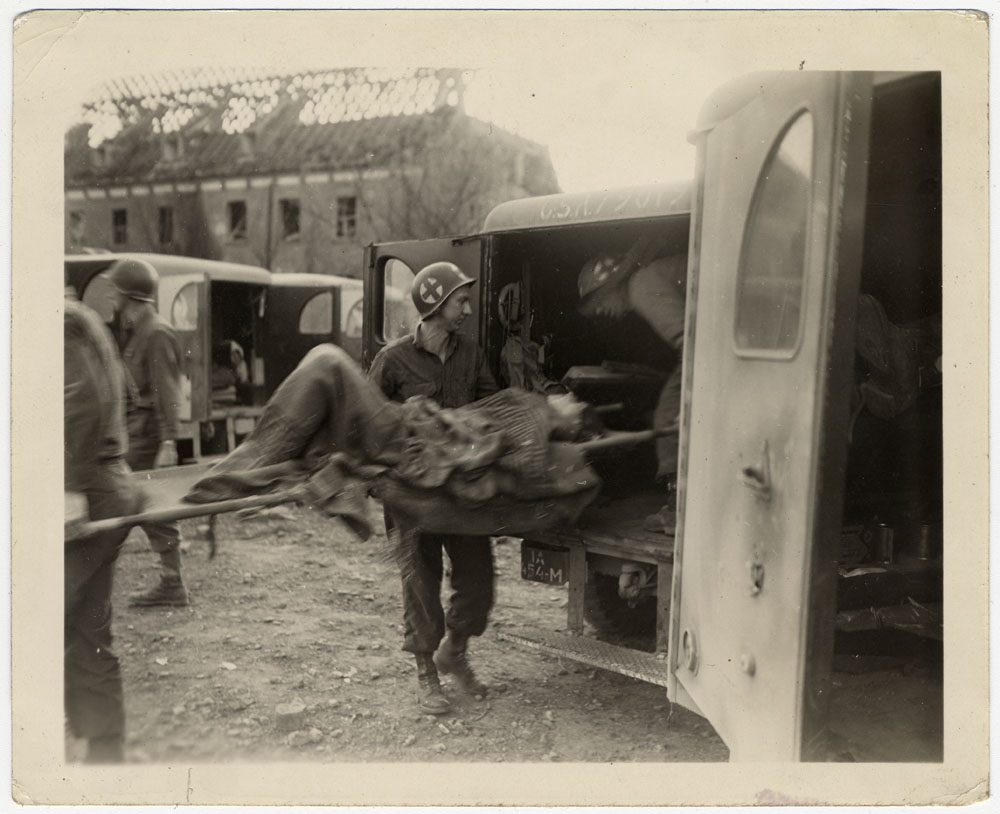
American Medical Personnel Evacuate Survivors for Medical Treatment at the Dora-Mittelbau Concentration Camp
In early April 1945, with U.S. forces closing on the area, the SS began to evacuate the prisoners from Dora-Mittelbau, with most sent to Bergen-Belsen in northern Germany. When U.S. forces entered the camp in early April, only a few sick and dying prisoners were still alive.

American Medics Evacuate Survivors from the Dora-Mittelbau Concentration Camp
In early April 1945, with U.S. forces closing on the area, the SS began to evacuate the prisoners from Dora-Mittelbau, with most sent to Bergen-Belsen in northern Germany. When U.S. forces entered the camp in early April, only a few sick and dying prisoners were still alive.

A Polish Survivor Shows U.S. Soldier John L. Lyndon the Crematorium Ovens Used to Burn Corpses at Dora-Mittelbau Concentration Camp
Polish survivor shows US soldier John L Lyndon the crematorium ovens which was used to burn corpses at Dora-Mittelbau concentration camp.

Entrance to Dora-Mittelbau Concentration Camp
The 3rd Armored Division discovered the Dora-Mittelbau concentration camp on April 11, 1945. The camp, located near the town of Nordhausen, was – like Ohrdruf – originally created as a subcamp of Buchenwald in order to produce the V-1 and V-2 rockets.

Armored Division Soldier with Camp Survivors at Dora-Mittelbau Concentration Camp
The 3rd Armored Division discovered the Dora-Mittelbau concentration camp on April 11, 1945. The camp, located near the town of Nordhausen, was – like Ohrdruf – originally created as a subcamp of Buchenwald in order to produce the V-1 and V-2 rockets.

Germans Dig Graves
A soldier of the 1st Army watches as local German civilians are forced to dig graves for the nearly 2,500 victims discovered at the Dora-Mittelbau camp. As local Germans were assumed to have known that atrocities were taking place, U.S. servicemembers also made them walk through the camp in order to view the horrors.

Sixteen of the Nineteen Defendants on Trial for War Crimes Committed During the War at Dora-Mittelbau
In August 1947, an American military tribunal brought to trial nineteen of the former camp personnel to face charges for acts committed against prisoners.

Buchenwald
As the 3rd Armored Division entered Dora-Mittelbau, American forces to the south were simultaneously entering Buchenwald. One of the largest concentration camps in Germany, Buchenwald was established to incarcerate political prisoners, and following Kristallnacht when Jewish businesses, synagogues, and homes were attacked, Jews came to represent a large portion of the population as well.

“They Will Know Food Again”
As the 3rd Armored Division entered Dora-Mittelbau, American forces to the south were simultaneously entering Buchenwald. One of the largest concentration camps in Germany, Buchenwald was established to incarcerate political prisoners, and following Kristallnacht when Jewish businesses, synagogues, and homes were attacked, Jews came to represent a large portion of the population as well.

Survivors of Buchenwald Concentration Camp
When the 6th Armored Division entered the camp, they encountering nearly 21,000 prisoners left behind by the Nazis.

American Troops and Survivors look at Sign on Building
A Chicago native, Jack Levine served in the U.S. Army during World War II. As a member of the 6th Armored Division, he was one of the first soldiers to enter the camp and is seen here, along with two other U.S. soldiers and a former prisoner at Buchenwald. The sign, painted by prisoners on a barracks building, welcomed the American liberators.

Pass to Enter Buchenwald Concentration Camp
Military pass issued to Jules Barrash allowing him to enter Buchenwald concentration camp; dated April 16, 1945. Dr. Jules Barrash was a Jewish native of Chicago drafted into the U.S. military. While in service, he became a medic and arrived at Buchenwald two days after its liberation.

Lothar Kahn with Survivors of Buchenwald Headed for Displaced Persons Camp
Lothar Kahn was a German-Jew born in Gemünden am Main, Germany in 1924. Lothar’s brother Arthur was shot by the Gestapo in 1933, and his father was arrested on Kristallnacht and taken to Buchenwald. Following his father’s release, Lothar and his parents were able to follow another brother on a Kindertransport to London in mid-1939, subsequently immigrating to the U.S. on the eve of Passover in 1940. Lothar was drafted into the U.S. Army in 1943 and served in Germany and France. At the end of the war he was appointed as an interpreter and assisted survivors coming through Bamberg, Germany.

American Soldier next to of Trainload of Buchenwald Survivors Headed for Displaced Persons Camp
American soldier next to train cars loaded with Buchenwald survivors heading to displaced persons camp.

Flossenbürg
The concentration camp at Flossenbürg was comprised primarily of political prisoners, German criminals convicted of repeated crimes, and following the 1941 invasion of the Soviet Union, Soviet POWs. With a few thousand prisoners at any given time, the camp’s prisoners were forced to quarry granite and produce aircraft materials for the Messerschmidt company.

Seventeen-year-old Jewish Boy Identifies his Father’s Body
On April 16 a transport carrying 1,700 Jewish prisoners left Flossenbürg as Allied forces made their way deeper into Germany. The transport was attacked by Allied airplanes and in the ensuing chaos many Jewish prisoners attempted to escape and take food and supplies. Following the attack, SS guards rounded up the prisoners and executed those too weak to continue and those suspected of taking food and supplies.

Dachau
One of the largest camps liberated by American forces was Dachau, the first concentration camp established by the Nazi government in 1933. Located a few miles from Munich, the camp was initially founded to imprison political opponents, though like other camps it eventually imprisoned thousands of Jewish prisoners as well.

Dachau Concentration Camp After Liberation
For the 35,000 remaining at Dachau, liberation came on April 29 as the 42nd and 45th Infantry Divisions entered the camp. In addition to the thousands of survivors, American troops also discovered nearly 2,000 victims of the Nazis on transport trains, sent to Dachau from various other camps around Germany.

They Lived Through
For the 35,000 remaining at Dachau, liberation came on April 29 as the 42nd and 45th Infantry Divisions entered the camp. In addition to the thousands of survivors, American troops also discovered nearly 2,000 victims of the Nazis on transport trains, sent to Dachau from various other camps around Germany.

Group Portrait of Survivors Standing Next to the Moat in the Dachau Concentration Camp Following Liberation
For the 35,000 remaining at Dachau, liberation came on April 29 as the 42nd and 45th Infantry Divisions entered the camp. In addition to the thousands of survivors, American troops also discovered nearly 2,000 victims of the Nazis on transport trains, sent to Dachau from various other camps around Germany.

A Memorial Sign in Front of the Crematorium in Dachau Concentration Camp
For the 35,000 remaining at Dachau, liberation came on April 29 as the 42nd and 45th Infantry Divisions entered the camp. In addition to the thousands of survivors, American troops also discovered nearly 2,000 victims of the Nazis on transport trains, sent to Dachau from various other camps around Germany.

Mauthausen
The Mauthausen concentration camp was comprised of several camps in Austria, utilizing forced labor to mine granite for Hitler’s grand architectural designs. Built in 1938, approximately 200,000 prisoners would pass through Mauthausen and its sub-camps by the end of the war, nearly half of whom would be killed by the SS or die working in the quarries.

Survivors Walk Along the Main Street of the Mauthausen Concentration Camp
Mauthausen concentration camp held prisoners from nearly every European nation, including tens of thousands of Soviet POWs and Yugoslavian resistance fighters. At the time of liberation there were tens of thousands of survivors in the camp.

In the Women’s Camp at Mauthausen Concentration Camp, Survivors Queue up for Soup
Until late 1943, Mauthausen housed very few female prisoners. A designation as a women’s concentration camp in 1944 paved the way for several hundred female political prisoners to be sent to Mauthausen, as well as an increasing number of Jewish prisoners. By March of 1945, there were nearly 2,500 women prisoners at the camp, the vast majority of whom were political prisoners of the Nazi regime.

POWs
Most of the camps liberated by Allied forces in the last days of the war housed political prisoners and Jewish survivors of the Holocaust. However, among the millions of survivors of the Nazi regime were millions of Allied POWs. The vast majority of the POWs were Soviet soldiers captured during the Nazi invasion of the Soviet Union in 1941, however approximately 94,000 American service members were held prisoner by Germany during the course of the war, as well as hundreds of thousands of Allied soldiers who had been taken prisoner during the course of the war.

Freed American POWs at Marktredwitz
Medics treat American POW Alvin Abrams, of the 28th Infantry Division, who survived a death march before being liberated by soldiers of the 90th Infantry Division. Private Abrams and other members of his division were taken prisoner during the Battle of the Bulge and subjected to a death march by the Nazis, before being freed by their fellow soldiers.

Emaciated American POWs Liberated at Limburg by 1st Army
These POWs, liberated by U.S. First Army Forces from a German prison camp near Limburg, were captured during the Battle of the Bulge.









































![The Philippine Expeditionary Force [translated]](/sites/default/files/styles/exhibit_thumbnail/public/c5/philippine_expeditionary_force_210px.jpg?itok=cpk_hzx5)
![Type 95 Shin Gunto [New Military Sword]](/sites/default/files/styles/exhibit_thumbnail/public/c5/type_95_shin_gunto_sword_210px.jpg?itok=vA2Tr1Nq)


























































































































































